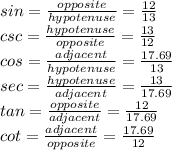Answer:
Explanation:
I don't know where you are in your class, or even what chapter you are in, but I solved this using a right triangle.
We don't need to know the angles, just the sides.
c is the hypotenuse, the line at a tilt
b is the adjacent line, directly below c
a is the opposite line
c = 13
a= 12
b = ?
In order to find b, we use the Pythagorean Theorem,
 , but we need to rearrange the problem to where we are solving for b instead of c,
, but we need to rearrange the problem to where we are solving for b instead of c,


So, b = 17.69
Now, we need to evaluate each of the trig. functions:

So, there is your answers, hope that is what you are looking for.